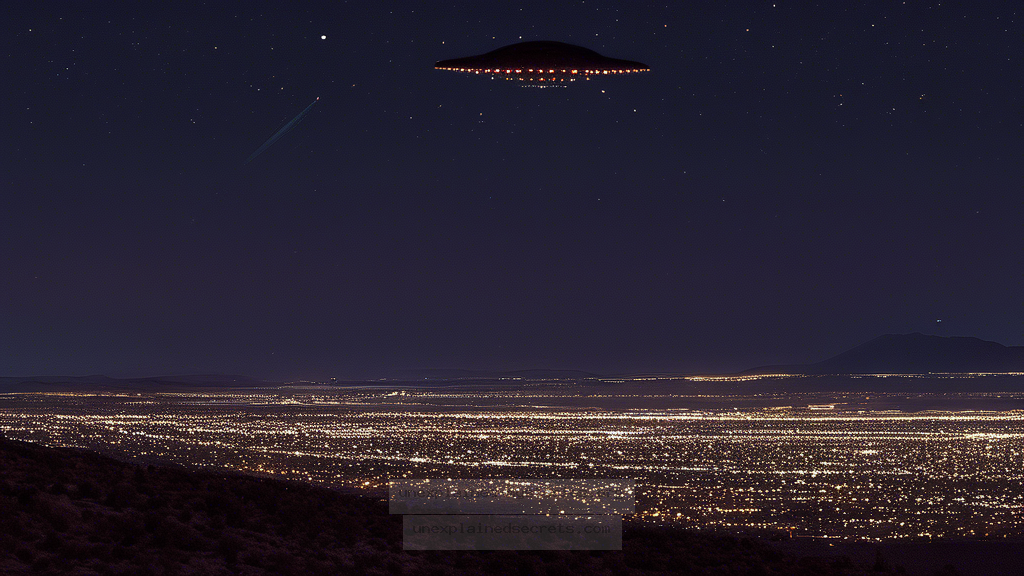What Really Happened During the Phoenix Lights Incident of 1997?
What Really Happened During the Phoenix Lights Incident of 1997?
The Phoenix Lights incident remains one of the most compelling and widely debated UFO sightings in modern history. On the night of March 13, 1997, thousands of residents across Arizona reported witnessing a series of mysterious lights in a V-shaped formation, leading to a wave of speculation regarding extraterrestrial visitors, military operations, and government cover-ups. The significance of this event transcends mere anecdotal evidence; it serves as a focal point for discussions on UFOs, public perception, and the complexities of government transparency. In this blog post, we will delve into various aspects of the Phoenix Lights incident, examining its historical context, core theories, and ongoing implications for UFO research. 💡
Historical Context: The Build-Up to the Phoenix Lights
The Phoenix Lights incident did not occur in a vacuum. To understand its significance, one must consider the historical context of UFO sightings in the United States. The 1947 Roswell incident is often cited as the catalyst for modern UFO culture, with countless reports flooding in over the decades that followed. By the 1990s, public interest in extraterrestrial phenomena had surged, fueled by movies, books, and a growing subculture of UFO enthusiasts.
The 1980s and 1990s saw a notable increase in reported sightings in Arizona, setting the stage for the Phoenix Lights event. The state’s vast desert landscape and clear skies made it an ideal location for both amateur and serious UFO watchers. The night of March 13, 1997, was particularly significant; a perfect storm of public curiosity and technological capacity (such as video cameras) allowed for extensive documentation of the phenomenon.
The Night of the Sightings: Eyewitness Accounts
On that fateful evening, between 7:30 PM and 10:30 PM, thousands of people reported seeing a series of lights across the Phoenix sky. Witnesses described seeing a massive V-shaped craft, with orbs of light that appeared to be attached to its underside. Accounts varied, with some individuals stating they saw a solid craft, while others described the lights as separate entities moving independently.
Among the most notable eyewitnesses was Phoenix mayor, Skip Rimsza, who initially dismissed the reports but later admitted he had seen the lights himself. Others included police officers, military personnel, and ordinary citizens, all of whom provided compelling testimonies that have stood the test of time. The sheer number of witnesses—over 1,000—makes this event particularly difficult to ignore.
Core Concepts and Theories: What Could It Be?
Several theories have emerged to explain the Phoenix Lights. Here are some of the most prevalent:
- Extraterrestrial Craft: The most popular theory among UFO enthusiasts is that the lights were part of an alien spacecraft visiting Earth. The V-shaped formation, coupled with the size and speed of the lights, has led many to speculate about extraterrestrial technology.
- Military Exercises: The U.S. military eventually claimed that the lights were flares dropped during a training exercise at the Barry Goldwater Range. Critics argue that flares do not account for the solid structure and the movement described by witnesses.
- Mass Hysteria: Skeptics suggest that the phenomenon can be attributed to mass hysteria, where a large group of people witnesses the same event and collectively misinterprets it. This theory, however, fails to explain the detailed and consistent accounts given by various witnesses.
Practical Implications: What Does This Mean for UFO Research?
The Phoenix Lights incident has had lasting implications for both public perception and the study of UFOs. The sheer number of witnesses and the media coverage it received have made it a cornerstone case in discussions about extraterrestrial life. Researchers often use the incident as a benchmark for evaluating other UFO sightings, considering factors like witness credibility and the nature of the evidence.
Furthermore, the incident has prompted calls for increased transparency from government agencies regarding UFOs. The U.S. government’s acknowledgment of unidentified aerial phenomena (UAPs) in recent years can be seen as a direct response to the demand for accountability stemming from events like the Phoenix Lights.
Alternative Perspectives: Skeptics vs. Believers
As with any significant event, the Phoenix Lights incident has its share of skeptics and believers. Skeptics argue that the lights can be explained through conventional means. For example, they point to the possibility of meteorological phenomena or aircraft lighting patterns. The military’s official explanation is also a cornerstone of the skeptical argument. However, many remain unconvinced, citing inconsistencies in the military’s narrative and the number of witnesses who reported a solid craft rather than mere lights.
On the other hand, believers argue that the sheer volume of eyewitness accounts and the quality of the testimony cannot be easily dismissed. They point out that the phenomenon has not been adequately explained by official narratives and that the government’s reluctance to fully disclose information only fuels speculation.
Common Misconceptions: Clarifying the Myths
There are several misconceptions surrounding the Phoenix Lights incident that deserve clarification:
- All Witnesses Were in the Same Location: Many believe that the sightings were confined to a specific area; however, reports came from various locations across Arizona, including Phoenix, Glendale, and even as far as Nevada.
- The Lights Were Just Flares: While some witnesses reported seeing lights in the sky that resembled flares, many others described a solid object moving silently across the sky, which flares cannot explain.
- It Was a Hoax: Despite some claims that the incident was a publicity stunt, no credible evidence has surfaced to support this assertion, and the large number of witnesses makes it unlikely.
Best Practices for Investigation: How to Approach UFO Sightings
For those interested in investigating UFO sightings, there are several best practices to consider:
- Gather Multiple Accounts: Collecting testimonies from various sources can provide a more comprehensive view of the event.
- Document Evidence: Encourage witnesses to take photographs or videos, and ensure they are cataloged for future analysis.
- Consult Experts: Engage with professionals in fields like astronomy and meteorology to rule out natural phenomena.
- Maintain Objectivity: Approach investigations with an open mind, balancing skepticism and belief.
Future Developments: Ongoing Research and Interest
The interest in the Phoenix Lights incident shows no signs of waning. New technology, such as advanced imaging and analytical software, is being developed to analyze historical sightings more effectively. In recent years, the U.S. government’s acknowledgment of UAPs has reignited public interest in the Phoenix Lights, drawing attention from researchers and enthusiasts alike.
Moreover, ongoing studies are examining the psychological aspects of UFO sightings, with particular emphasis on how belief systems shape perceptions. This multidisciplinary approach could provide new insights into why incidents like the Phoenix Lights capture the public’s imagination.
Conclusion: The Lasting Legacy of the Phoenix Lights
The Phoenix Lights incident serves as a compelling case study in the realm of UFO research. It challenges us to confront our understanding of the unknown and the boundaries of government transparency. Whether one views the lights as extraterrestrial visitors or military flares, the impact of the event on public perception and ongoing research is undeniable. As we move forward, the lessons learned from the Phoenix Lights will continue to shape discussions about UFOs, government accountability, and the broader question of whether we are alone in the universe. ✅
Other Articles
Recent Posts
- What Happened to Flight MH370? The Conspiracy Theories That Still Haunt Us
- What Secrets Lurk Within the Walls of the Infamous Trans-Allegheny Lunatic Asylum?
- What Evidence Supports the Existence of Bigfoot in the Pacific Northwest?
- What Happened to the Indus Valley Civilization? Unraveling the Mysteries of Ancient Urban Life
- Can Telepathy Be Scientifically Proven Through Laboratory Evidence?







